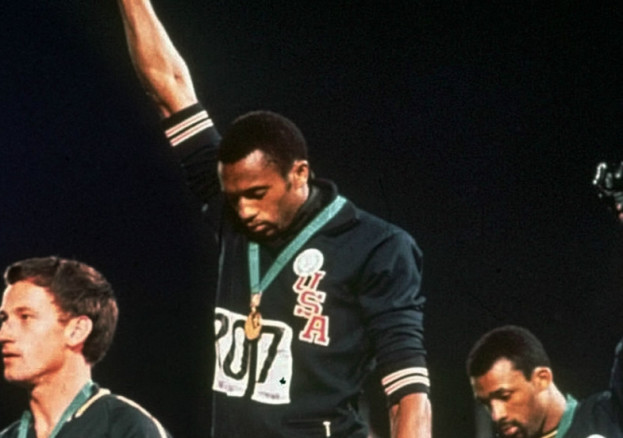
One of the most recognisable images of the 20th Century is the image of Tommie Smith and John Carlos on the first and third steps of the podium, with their gloved hands up, heads down and feet bare.
The build-up to the 1968 Summer Olympic games in Mexico City, was quiet and scandal free. However, just above their northern boarder in the United States of America, civil unrest had gripped the nation for more than a decade, which threatened to derail an Olympic schedule which they had been expected to perform.
For the past 18 years, the Civil Rights movement had been picking up momentum, culminating in the passing of the 1965 Voting rights act. Yet for ‘African-Americans’, the previous three years had not brought an improvement in living or working conditions, nor how Black Americans were seen within their own communities or overseas.
It meant that for many Black Americans, such as Professor Edwards, the chance for Black Americans to perform at the Olympics for the USA was just that; a performance, as if the athletes were ‘performing animals in the games.’
Professor Edwards and his organisation, the Olympic Project for Human Rights felt so strongly opposed to the conditions that Black citizens were subjected to, that he called for Black Athletes to boycott the 1968 games.
It was a decision that divided the African-American community to the core. On one side, the argument was that Black Americans should not represent a country that views them as second class citizens, and if it meant the United States missed out on medal winning opportunities because of it, it was the United States’ own fault. In contrast, the opposition felt that using the platform for athletic excellence provided an opportunity for the world to see Black Americans as people who are just as good- if not better, at what they do as their white peers.
Whilst the two sides differed on action, their core intent was the same: to show the world that Black Americans should be treated no different from their White peers and that should help to apply pressure for legislative change back home.
However, neither side had agreed to make the medal ceremony for the Men’s 200m Final the staging area for a silent protest, yet when the gloved fists of Smith and Carlos went into the air and became Olympic folklore- the US, and indeed the world, were forced to listen.
But in the 48 years since this iconic day in 1968, a missing part of this legacy has gone unnoticed, even though, in every image; bar the statue in San Jose, California- features the third and final member of this iconic image; Peter Norman.
Peter Norman was an Australian athlete in the 200m discipline and was, until his untimely death in 2006, an avid anti-apartheid and anti-discrimination supporter. Yet despite his public support for Racial equality, his position in iconic image in 1968, was never questioned, simply assumed to be another White man in an image of Black freedom.
But Peter Normans role in this image is one of an ally and was entirely deliberate.
Before the three took their steps on the podium, the winner of their event, Tommie Smith asked Norman two simple questions. “Do you believe in human rights?” and “Do you believe in God?”
Both times Peter Norman answered; ‘yes.’ Before saying “I will stand with you.”
By all accounts, the protest itself was not planned, yet it was intentional.
A closer analysis of the image shows that Carlos, the runner who placed third, has his glove on the left hand. This contrasts the traditional, right handed salute synonymous with Black Pride, as shown by Smith. The reason for this is simple; Carlos had forgotten his gloves back in the Olympic Village, and Smith only had one pair. However, if more pairs were available, Norman would have adopted a glove in solidarity with his fellow sportsmen.
Furthermore, the badge, which Norman wears, was not one he owned, but was borrowed from the US Rower, Paul Hoffman who he asked on the way to the podium.
These four men and their differing roles of involvement in the image, helped to create not only a symbol of the Civil Rights Movement, but one that would go on to serve as an Olympic Icon.
Nevertheless, all three athletes felt the fallout from the protest. Smith and Carlos were immediately sent home from the games, but would go on to continue a career in sport, with Smith going on to be an NFL player and Carlos remaining as a Track Athlete.
Norman, however, would become ‘blacklisted’ in Australia, never once appearing on behalf of the country again, despite setting the national record for the 200m in 1968- a record that still stands today.
As members of the Black Community, we remember Smith and Carlos for their inspiring individual performances as Athletes, and for their contribution to the Civil Rights Movement as Activists.
Yet the truth is far more powerful than the narrative we have been lead to believe. Consider this. A silent protest against racial discourse took place on the winner’s podium at the 1968 Olympic games, and the three fastest men in the world each believed that all men were created as, and therefore should be treated, as equals.
